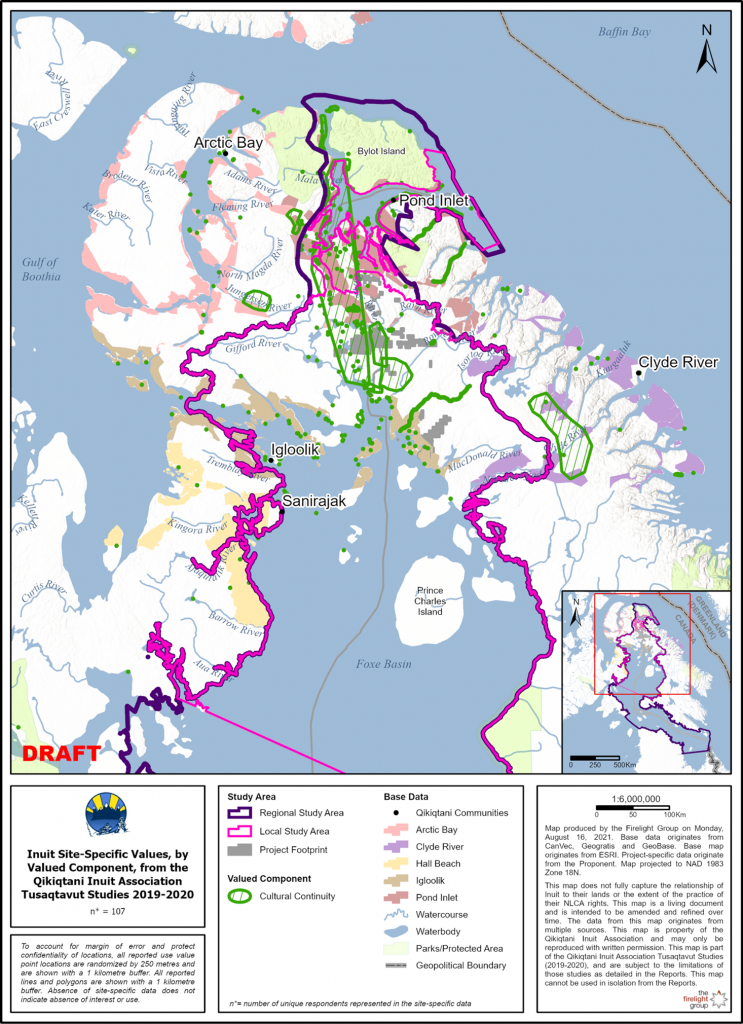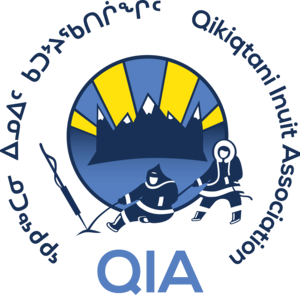At its core, cultural continuity means the persistence of the Inuit way of life and worldviews. This naturally includes activities and values linked with marine hunting, land-based harvesting, fishing, collection of freshwater, and travel and camping on the land. But, as we learned from community members, cultural continuity also involves many physical and “intangible” (or non-physical) values.
What kinds of Cultural Continuity information was recorded?
Community members described to us important places like burials and birthplaces, soapstone collection areas, places that have historical (e.g., whaling stations, sod houses) or spiritual importance, as well as place names and landmarks, places where families and communities gather on the land, and teaching areas where Inuit Qaujimajatuqangit (IQ) is transferred to younger generations.
This was a calving ground for caribous. When they give birth the placenta comes out throughout this area and from the reflection from the sun and the placentas that were left behind, it has a shine from all the placentas that were left behind by caribou’s giving the birth. That’s the meaning of Qilituq because when the sun is shining it’s reflecting from the placenta material I guess, yeah. (A09, 04-Nov-20, interpreted from Inuktitut)
We learned from community members that, although harvesting and hunting activities are fundamental to the Inuit way of life, there is much more to Inuit culture and the land. This includes, for example, Inuit art and technologies, archaeology and other heritage resources and values, connection to the land, and the act of teaching and learning Inuit Qaujimajatuqangit.
Yes it’s very important for younger to learn and to hunt because it’s our way of life. That’s how our ancestors survived … It was the country food that they harvested, and I tried to give the—my knowledge to my children as my dad did, and uncles, my brothers, my relatives that matter. (C04, 19-Oct-20)
Yes it’s very important for younger to learn and to hunt because it’s our way of life. That’s how our ancestors survived … It was the country food that they harvested, and I tried to give the—my knowledge to my children as my dad did, and uncles, my brothers, my relatives that matter. (C04, 19-Oct-20)
Community members told us that the collection and carving of soapstone is both culturally important as an art and as source of income. We heard that community members also carve with other materials, such as whale bones, which are also turned into tools.
… his family members and community members used that area [around the Project] a lot before Mary River was established. It was the main area where the community would go harvest, or mine soapstone. (C13 2020, interpreted from Inuktitut)
The history of the Inuit people on Baffinland is recorded in oral histories, but also place names (which are connected to legends, land uses, and family histories) and physical signs of occupation, such as Inuksuks, sod houses, tent rings, and burials.
And then, traditionally, people from Igloolik and Arctic Bay and Pond Inlet used to walk and gather … inland and they would gather there together … Yeah, the three communities would meet in this big lake to harvest caribou … there’s a lot of Inuksuks and landmarks that are indicating some areas where they used to go. (A12 2020, interpreted from Inuktitut)
We heard that Inuit Qaujimajatuqangit includes more than knowledge of the land and animals (e.g., mating behaviours, reading ice conditions, etc.), but also important Inuit beliefs, values, and protocols that ensure people are living in balance with each other and the land. Only harvesting what you need and sharing with others are examples of these principles.
You should always be fearful of the animals because they can hear you. You can never so sure that you’re going to get them… (I16, 28-May-19, interpreted from Inuktitut)
The importance of teaching
Speaking with members of all five communities, we learned that, at the centre of the Inuit way of life, is the ability to continue learning and teaching the rich and complex body of knowledge that defines what it means to be Inuit. These include skills for how to survive in the Arctic, how to navigate the land and sea, and how to understand the behaviours of animals and hunt successfully, among many other kinds of knowledge.
Community members emphasised to us the importance of hands-on learning on the land, and how important it is to have youth learning directly from experienced family and friends. Oral history and the oral tradition of learning continues to be a core way for knowledge to be passed on from generation to generation. Learning is personal, direct, and social. Gatherings within and across communities are, for instance, a key way for information from distant places to be shared.
Important Areas for Cultural Continuity
Community members shared places and values of cultural importance throughout Baffin Island, including many close to the Mary River Mine’s planned activities. Regions emphasised by Pond Inlet residents include Eclipse Sound, along upper Phillips Creek, the shores of Qinngua, and the Bruce Head area. Community members from Pond Inlet also shared with us many sites of cultural importance on the southern shoreline of Bylot Island and on Emerson Island. Arctic Bay and Clyde River community members highlighted similar areas in north Baffin Island.
Complementing the information shared by Pond Inlet, Arctic Bay, and Clyde River communities, Iglulik and Sanirajak residents focused on more southern portions of Baffin Island. Values identified by Uglulik and Sanirajak community members are found throughout northern Foxe Basin, as well as values identified around Igloolik Island, on the island of Kapuiviit, in the Ikpikitturjuaq area, and on Aivirjuaq.

Possible impacts from Mary River on Cultural Continuity
It is clear from speaking with community members that cultural continuity is closely linked with nearly all other aspects of the Inuit way of life discussed so far. Because of this, impacts to other cultural activities and values – from camping and travel, to the collection of soapstone, to hunting and trapping – are also likely to impact cultural continuity.
The Mary River Project also has the potential to disrupt landmarks used by community members to navigate the land, and to impact heritage resources and values (e.g., through construction and ground disturbance) that connect current generations with the past. Moreover, we heard that the Mary River Project could affect the ability of community members to use the land in preferred ways – that is uninterrupted and with a sense of peace and safety.
Fewer opportunities to hunt, fish, travel, and camp because of rail lines and shipping activities mean fewer opportunities to learn on the land and sea. By reducing the time that people get to spend together and sharing of resources, there are also consequences for social connections. Ultimately, community members are worried that the Mary River Project could disconnect people from their culture and identity.
In summary, the impacts from the Mary River Project, combined with impacts from existing operations and other changes, will directly and indirectly impact the ability of Inuit from Pond Inlet, Arctic Bay, Clyde River, Iglulik, and Sanirajak to hunt, fish, travel, harvest, and share knowledge between generations on the land, ice and water.

